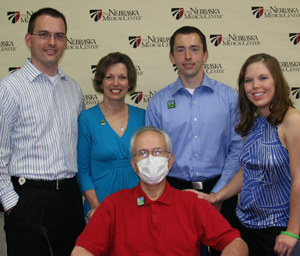 |
Bruce Prenosil, front row, headed home recently from The Nebraska Medical Center, where he received a heart transplant. Pictured with Prenosil are his family, from left, Tom, Joan, Josh and Sarah Prenosil. |
A “believe” sign sits on his fireplace mantel. And wherever he goes, the word just seems to jump out at him.
A bag appeared on his doorstep this month with the word “believe” printed on it.
And while recently stuck in traffic, the license plate in front of him read, “BLV 2 RCV” (Believe to Receive).
Since he was put on the top of the heart transplant list in April, Prenosil believed he would get a new heart in time to keep him alive.
Church announcement ushers in new life
On July 19, Prenosil didn’t need to believe anymore, he knew. Even before he received the call from UNMC’s hospital partner, The Nebraska Medical Center, he seemed to know the phone would ring.
That Sunday morning he told his wife, Joan, that he had a dream that a heart was offered. Later that day, in the middle of the church service, an announcement was made from the pulpit: “Sorry to interrupt. Bruce Prenosil, they have a heart for you.”
Prenosil had turned off his phone for the church service and didn’t realize The Nebraska Medical Center had been calling him.
The congregation erupted in applause and the family rushed to the hospital.
Sunday at 8:30 p.m., Prenosil was wheeled into the operating room at The Nebraska Medical Center. At 11 p.m., the new heart arrived. The transplant, performed by Mohammed Quader, M.D., associate professor of cardiothoracic surgery at UNMC and director of the medical center’s heart transplant program and his team, lasted four hours.
Family faces familiar prospect
The Prenosils are familiar with the heart transplant process. Their daughter, Sarah, now 23, was born with heart problems and had a heart transplant at age 14 at St. Louis Children’s Hospital (before The Nebraska Medical Center had a heart transplant program). She became a high school swimmer for Roncalli High School and is now a student at the University of Nebraska at Omaha.
|
Device buys patient time
In 2003, Prenosil was diagnosed with heart disease and received a pacemaker-defibrillator. Eventually diagnosed with congestive heart failure, he received a mechanical assist device in February called the Thoratec HeartMate II Left Ventricular Assist Device (LVAD).
“The FDA had just approved the use of HeartMate II,” said Ioana Dumitru, M.D., assistant professor of cardiology at UNMC and heart failure specialist at The Nebraska Medical Center. “Bruce was an excellent candidate for the device. He would have died without it.”
How the device works
The mechanical assist device takes over the function of the left ventricle, a pumping chamber of the heart. The HeartMate II uses a small turbine, similar to a screw, which spins and moves the blood into the aorta. The device also requires a constant energy supply and made it necessary for Prenosil to wear a mobile battery pack or stay close to an electrical outlet.
“The HeartMate II made Bruce strong enough for transplant,” Dr. Quader said. “The mechanical assist device gives patients waiting for heart transplant needed time to regain nutrition, strength and mental preparation to go forward with heart transplantation surgery. Bruce needed all of them and he made the most of the HeartMate II support.”
Quick recovery ensues
Just 12 hours after transplant, while still on a ventilator, Prenosil motioned to his wife Joan for a piece of paper. As his hand shook, Prenosil scratched jagged letters across the paper; a note to his wife and sister. It read, “I love you both. I feel…” Not able to finish the sentence, Joan did it for him after she received a nod of approval from her husband. She added, “Great.”
Prenosil was amazed at how well he felt shortly after transplant. And just 10 days post-transplant, he headed home.
“I want people to know about the wonderful transplant team here at the medical center,” Prenosil said. “It’s really a great team and people should know they don’t have to travel to other cities to get this kind of care.”